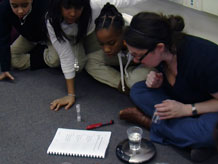What changes and what stays the same when salt dissolves in water?
3. Demonstrate dissolving
About Solutions
(background for teachers and not students)
When one substance dissolves in another, the resulting mixture, called a solution, is homogeneous - the concentration of each substance is the same throughout - and gravity will not cause the two substances to separate. Solutions do not appear cloudy.
Salt dissolves in water up to a point when the solution becomes saturated (38 grams of salt per 100 grams of room temperature water). Beyond the saturation point, excess salt will not dissolve; it will remain visible as grains of salt.
Salt or other dissolved solids will return to their solid state as water evaporates. Dissolving is reversible because the substances (in this case, water and salt) do not combine through a chemical reaction.
Cocoa does not dissolve in water; it remains suspended in the water for a period of time but eventually will settle to the bottom.

Remind students of the investigation question:
What changes and what stays the same when salt dissolves in water?
Are students familiar with the term dissolve? Ask for their ideas.
Pour 20 grams of salt into a 12oz cup half filled with water and stir.
- Taste might be helpful, but can't be done in school. (Also, taste cannot indicate how much of the original salt is still in the water.)
- Evaporate the water, but that will take a long time.
- Weigh the materials prior to and after dissolving the salt.
Once students understand that tracking the weights is the most reliable way to understand if dissolved salt is still in the water, they can move forward with their own exploration.
Note: Caution students to never to put anything in their mouths in class. Although the water, salt, and cups are probably clean and safe, do not taste.



